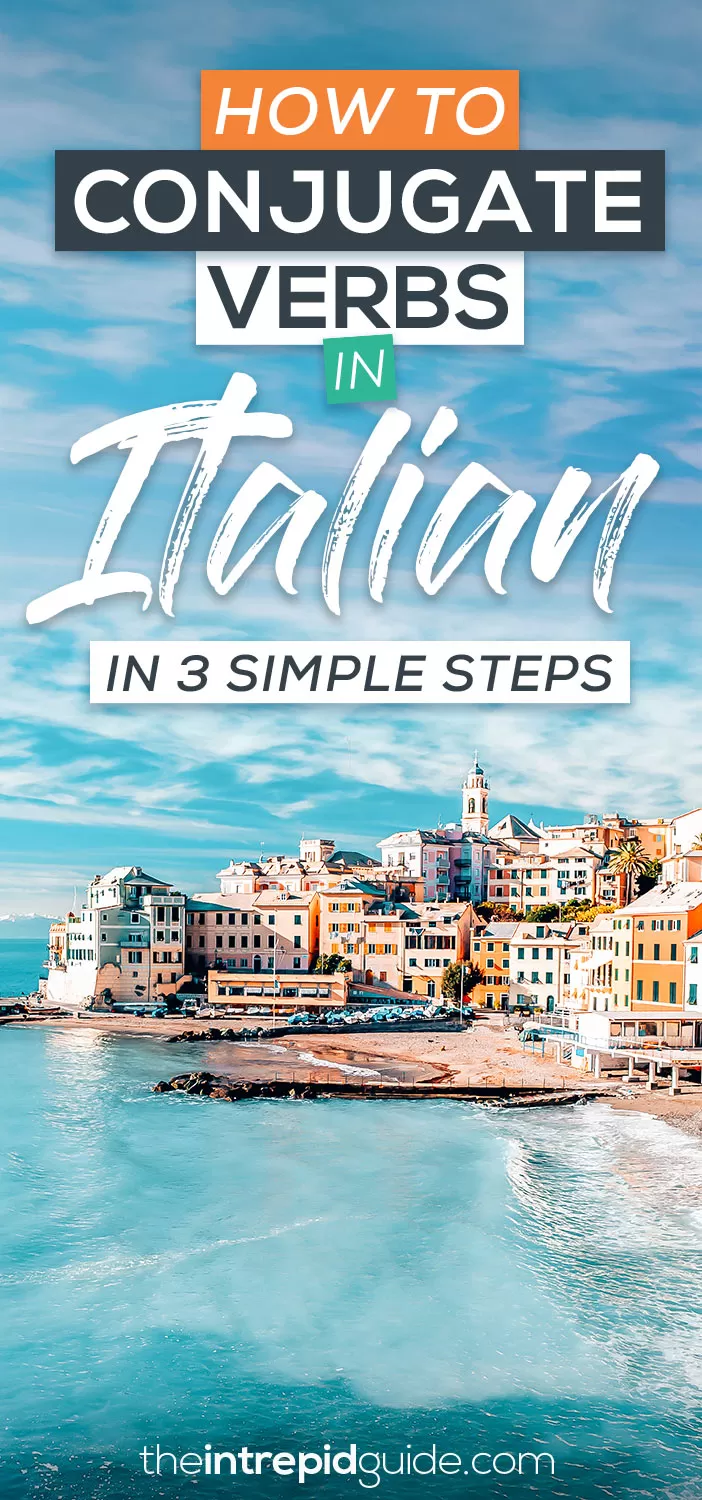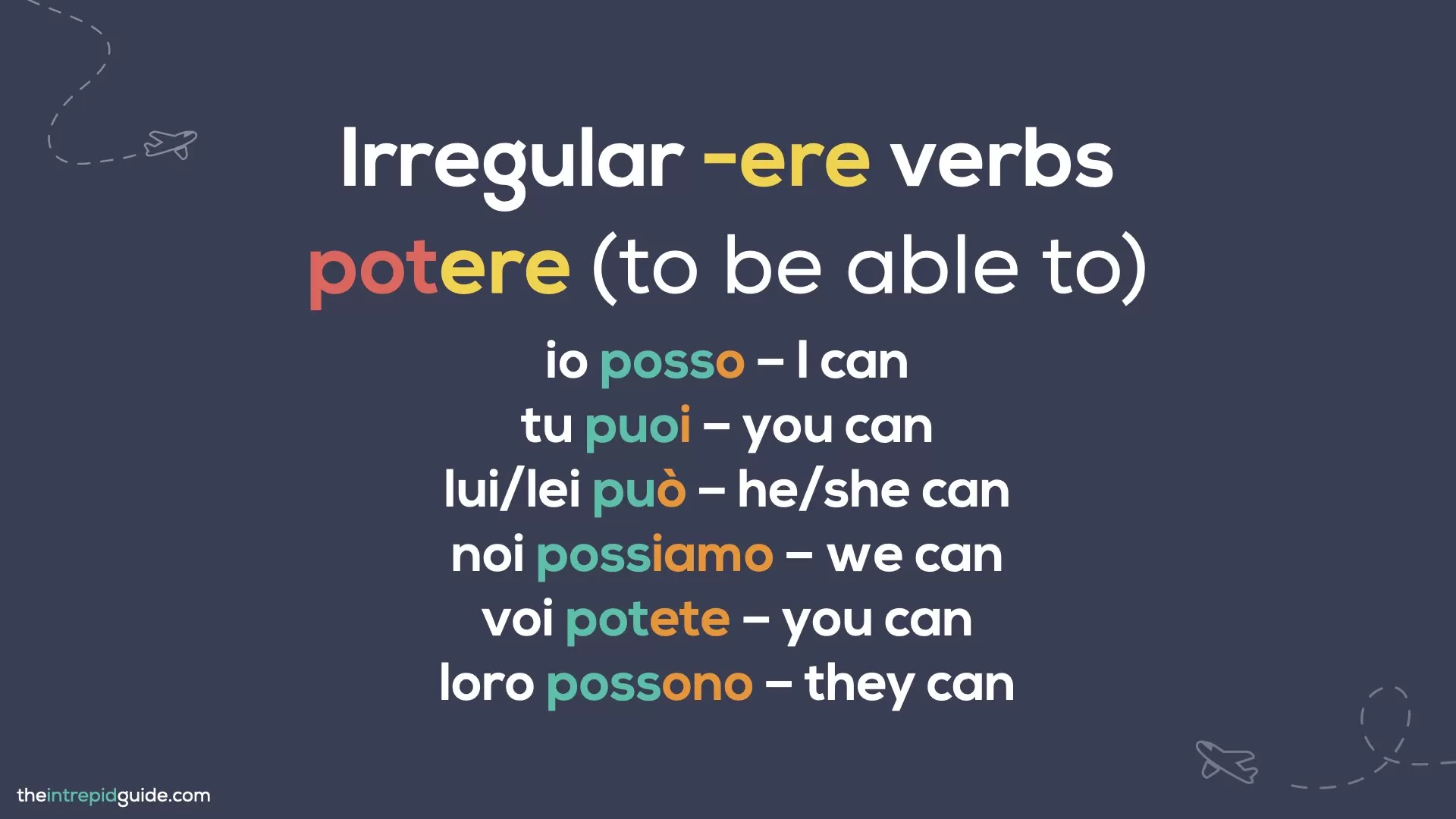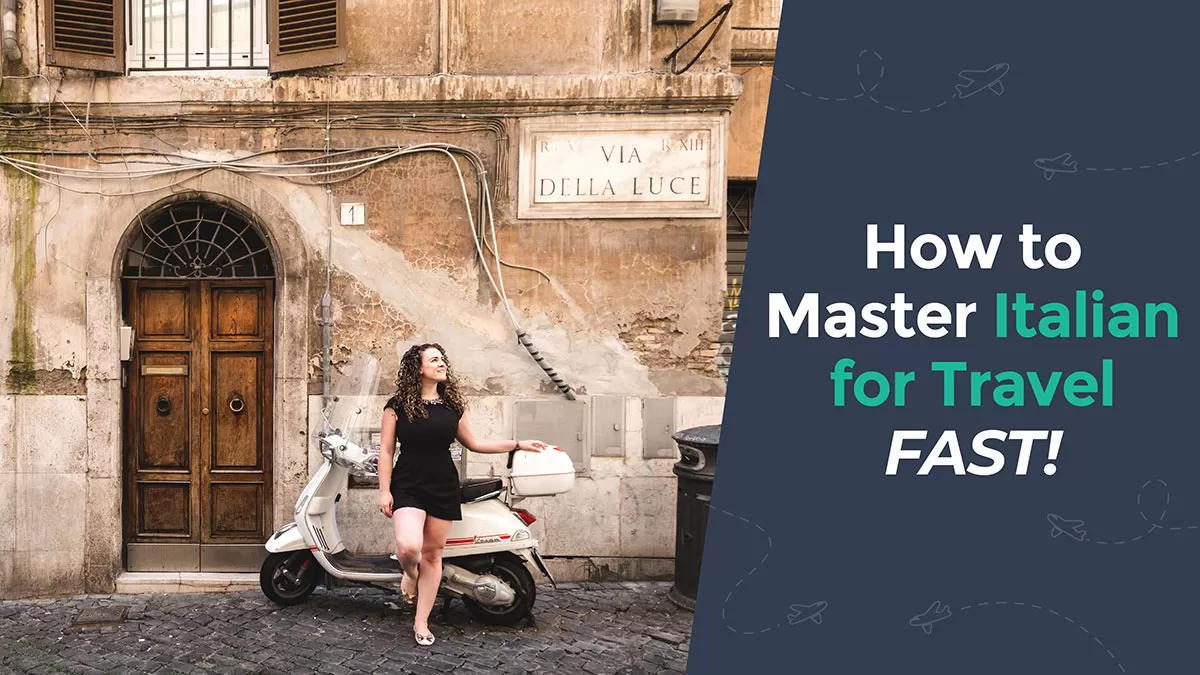Learning Italian? If you want to say anything in Italian, you NEED to know how to conjugate Italian verbs. It might sound, or even look overwhelming at first, but with these 3 simple steps, conjugating Italian verbs is facile! (easy!)
We’re going to go back to basics because when it comes to language learning, assuming anything is a big mistake. When I first started learning Italian, before I could learn how to conjugate a verb, first I had to really understand what it was.
So, let’s talk about verbs!
Just looking at the word may conjure up negative feelings from boring grammar lessons at school. You may have even gone your whole adult life and still don’t know what they are!
Don’t worry! I didn’t know what they were either. That is, not until I studied Italian.
I’m going to break down this seemingly ‘scary’ grammatical term and make it super easy for you to understand and remember what verbs are.
Why?
Because as you learn Italian, you will see similar-looking words but every so often they will have a slightly different ending, which means their meaning will be different too. Without a doubt, learning how to conjugate verbs in Italian is one of the most important and powerful steps in the learning process.
Cominciamo! (Let’s get started!)
So, what is a verb?
A verb is a word you can place ‘to’ in front of, like ‘to travel’, viaggiare (vee-ahj-jaarh-reh) or ‘to eat’, mangiare (mahn-jaarh-reh). These examples are in their full form, which is called the infinitive. The infinitive form of a verb is the unconjugated verb.
What is an unconjugated verb?
An unconjugated is when the verb doesn’t tell us who is doing the action. Every time you speak, you change verbs to reflect the subject of the verb. The process of changing verbs is called conjugating. For example, if you say ‘She’s eating a pizza’, then she is the subject. She is the person conducting the action. She is eating the pizza.
Therefore, in Italian, you couldn’t just say mangiare una pizza on its own because this means ‘eating a pizza’. Instead, you have to conjugate the verb mangiare and say lei mangia una pizza, ‘She’s eating a pizza’. It is important to be able to recognize verb infinitives as this is how they are organised in your common dictionary.
*Tip: For a list of common Italian verbs, get my free guide here. It includes a FREE PDF cheat sheet you can download and practice with.
How to conjugate Italian verbs
So, let’s learn how to Italian conjugate verbs in the present tense. In grammatical terms, this is called the present indicative tense. I know, it’s a scary-sounding term. But, try not to focus on that. It just means that it’s used to express or indicate facts.
The indicative tense is the most commonly used mood in everyday conversation and what we will focus on in this guide.
The present indicative, as its name implies, is used to form statements and questions in the present tense, in other words, things that are happening now.
In English, the present tense can be expressed in three different ways:
- The simple present: ‘I eat’
- The present progressive: ‘I am eating’
- The emphatic present: ‘I do eat’
However, in Italian, we can express all three of these meanings just by saying mangio (mahn-joh) (I eat). That’s right! You get all three for the price of one! In Italian, there is no am-ing, is-ing or are-ing. Ever noticed when some native Italians speak English they say things like ‘I go tomorrow’, or ‘I go now’ instead of ‘I’m going tomorrow’ or ‘I’m going now’? This is because they don’t use –ing endings to describe what they are doing now (in the present) or what they are going to do (in the future). It’s broken English to our ears, but 100% correct in Italian. Remember this when you speak Italian.
What are Subject Pronouns?
In order to conjugate Italian verbs, we must first familiarise ourselves with subject pronouns. Subject pronouns in English are – I, you (singular), he/she/it, we, you (plural), and they.
Here they are in Italian:
- io – I
- tu – you (informal)
- Lei/lui/lei – you (formal), he, she
- noi – we
- voi – you (plural)
- loro – they
In Italian, subject pronouns come before the conjugated verb but their use differs from English. Subject pronouns are only used to add emphasis to the subject or for clarification. To add a similar emphasis in English, we simply stress the pronoun by increasing our voice slightly.
As you will learn in the examples I’m about to share, the subject is already part of the conjugated verb and is represented by the final letters. This is worth repeating. The subject (thing or person) who is doing the action, is represented by the final letters of the verb in Italian.
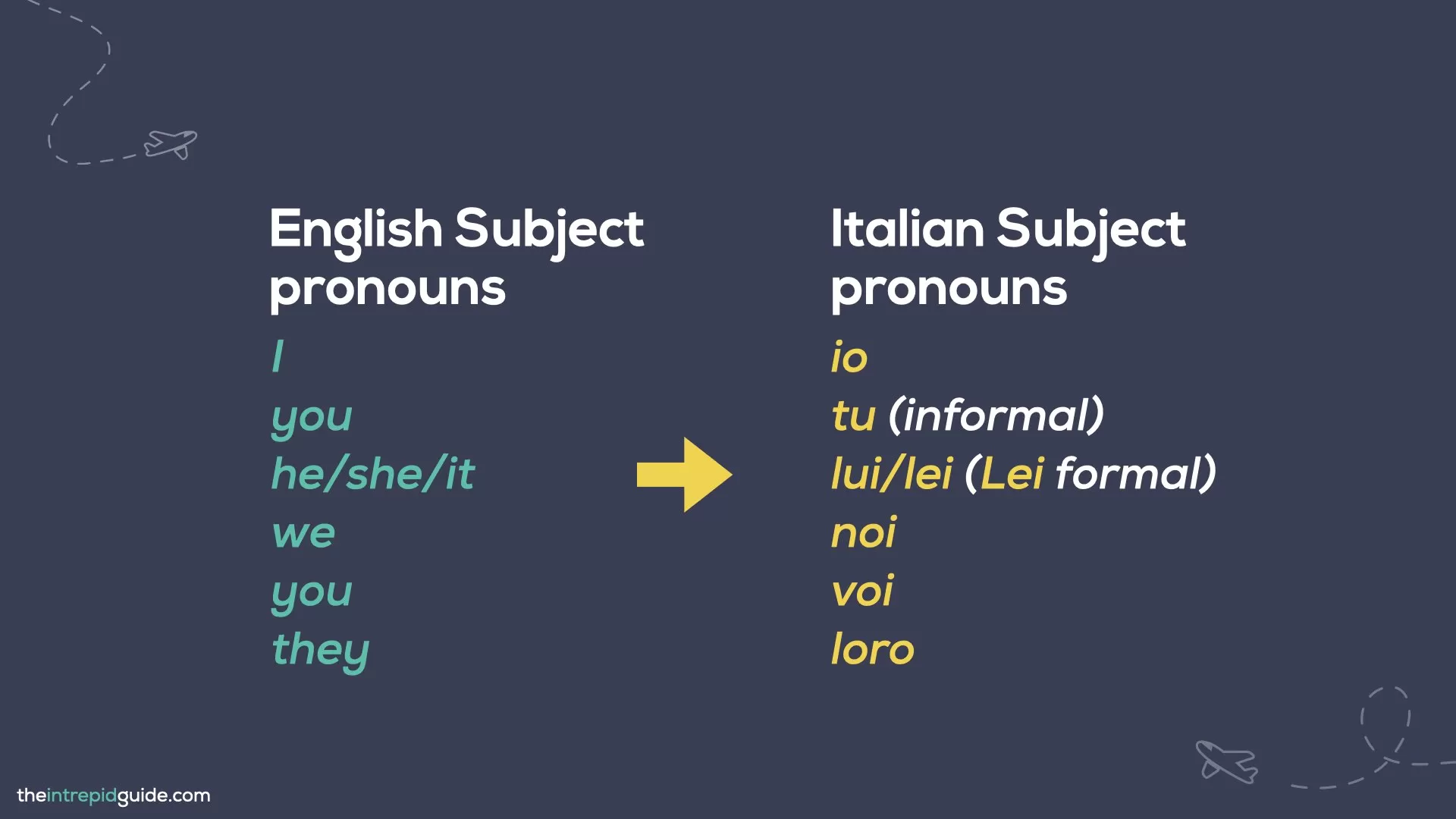
Italian Verb Families
Most of the time Italian verbs follow certain rules. We call these regular verbs. The ones that don’t follow the rule are called irregular verbs. We’ll cover these later.
All verbs in Italian belong to one of three families which can be easily identified by their endings, -ere, -ire and -are. These endings represent the ‘to’ part of the verb (eg. to eat, to travel) as they are always found in the infinitive. This is how you’ll be able to identify the infinitive. Just look for any of these three final letters combinations.
The rules are the same for each family, so after you’ve learned the pattern for one verb, you’ll know how to conjugate all the verbs in that family. As if by magico!
- The first type of conjugation is the -are family which is the largest and most regular. eg. parlare (par-lah-reh) to speak
- The second type of conjugation is the -ere family which has its own set of rules. eg. prendere (pren-de-reh) to take
- The third type of conjugation is the -ire family which has two methods of conjugation. eg. capire (kah-pee-reh) to understand
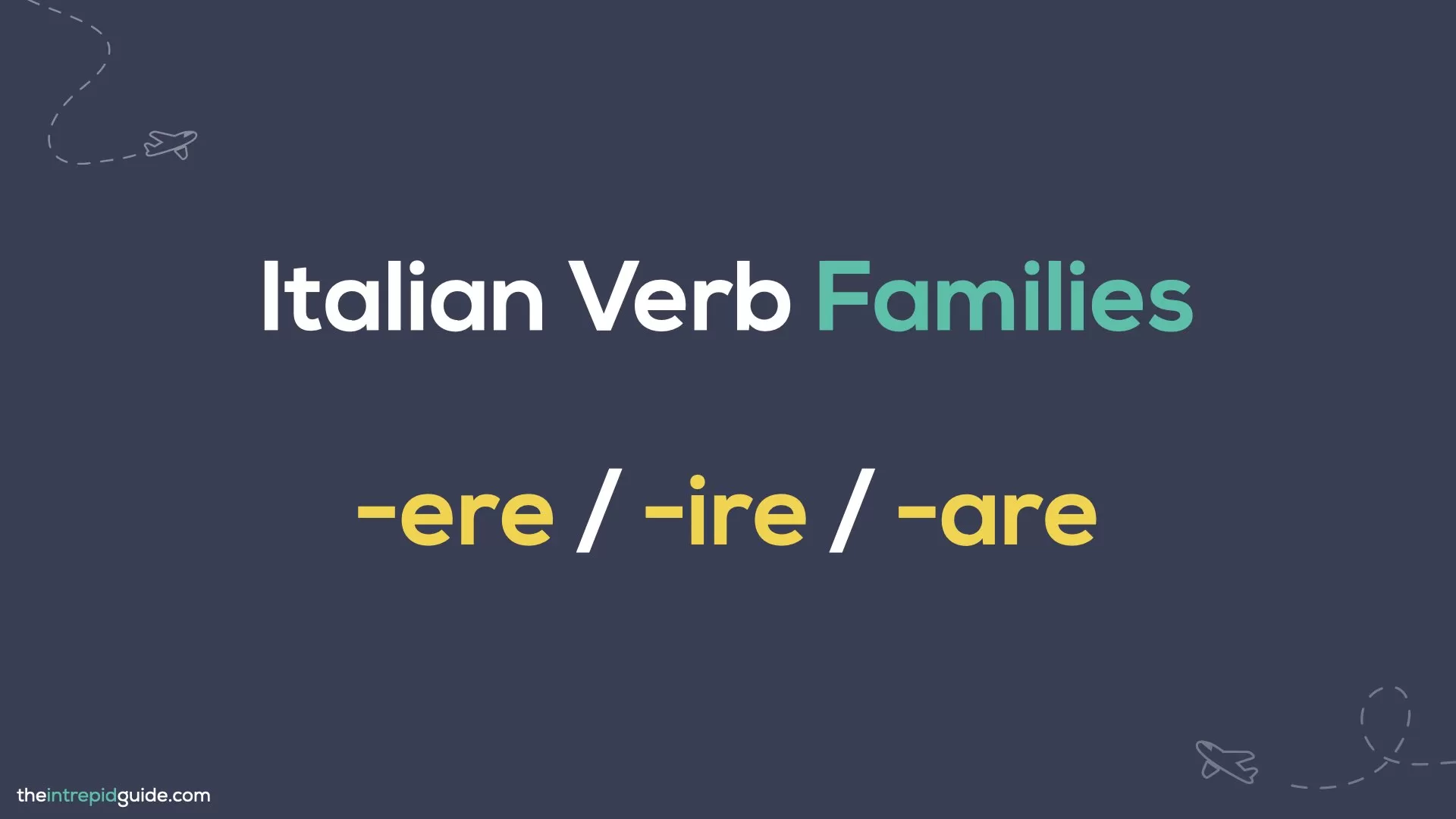
Using the Stem to Conjugate Verbs
If -are, –ere and -ire are called the infinitive ending, then what is left is called the stem. In other words, the first part of the verb. By using the stem, you can start to conjugate verbs! To conjugate any regular Italian verb in the present tense all you need to do is follow these 3 simple steps:
- Keep the stem
- Drop the infinitive ending
- Replace the ending with the appropriate conjugation.
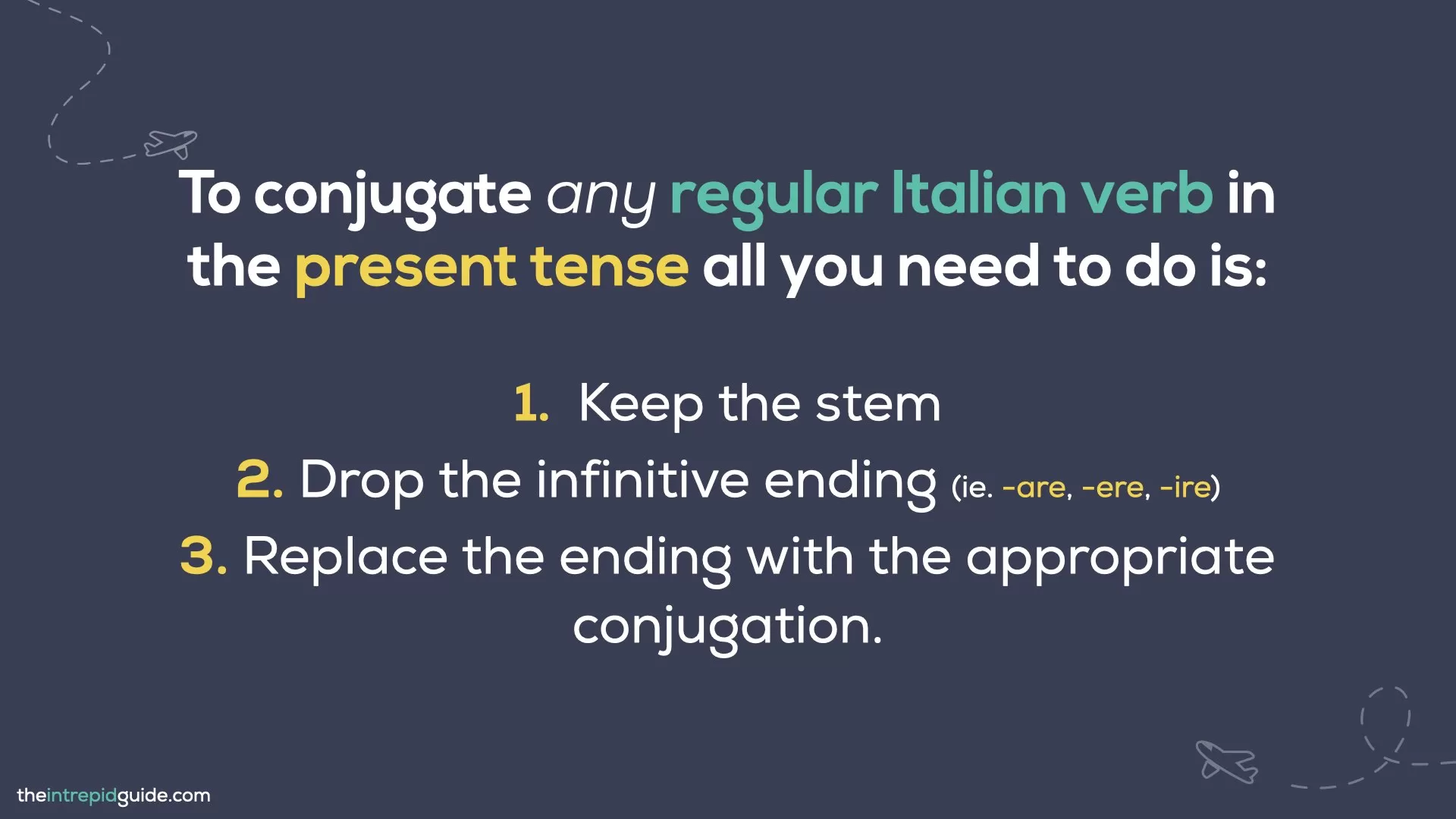
How to obtain the stem:
- chiamare → chiam – are (to call)
- chiudere → chiud – ere (to close)
- servire → serv – ire (to need)
Once you have the stem you can add the following endings.
-ARE verb endings
The endings for -are verbs are: -o, -i, -a, -iamo, -ate, -ano
- -o (oh) – I
- -i (ee) – you
- -a (ah) – he/she/it
- -iamo (ee-yah-moh) – we
- -ate (ah-teh) – you (plural)
- -ano (ah-noh) – they
With these endings, we can now conjugate the verb parlare (pah-lah-reh) (to speak).
- io parlo (ee-oh parh-loh) – I speak
- tu parli (tooh parh-lee) – you speak
- Lei/lui/lei parla (lay/loo-ee/lay parh-lah) – You (formal)/he/she speak(s)
- noi parliamo (noy parh-lee-yah-moh) – we speak
- voi parlate (voy parh-lah-teh) – you speak
- loro parlano (lor-roh parh-lah-noh) – they speak
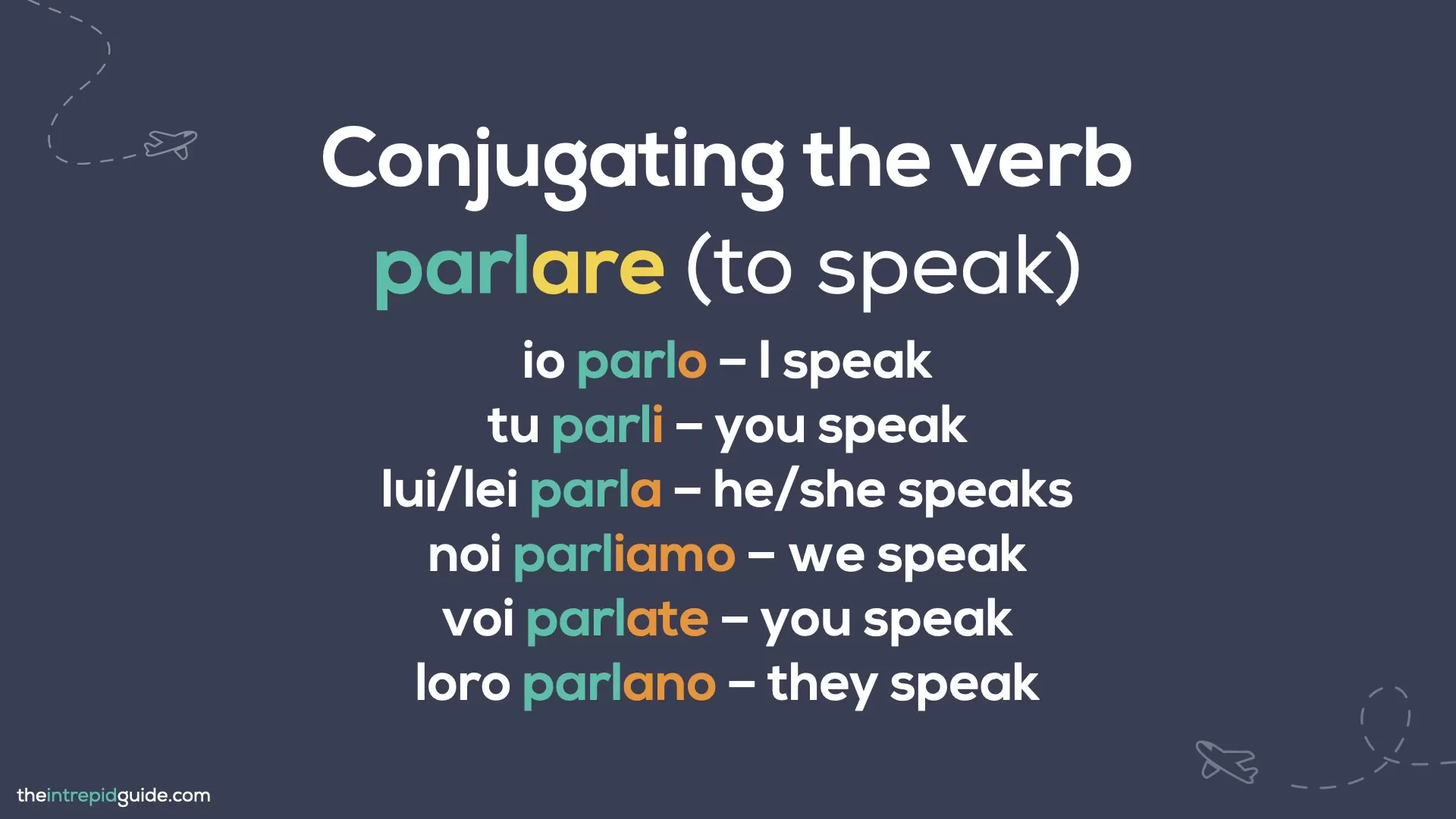 -ERE verb endings
-ERE verb endings
The endings for –ere verbs are: -o, -i, -e, -iamo, -ete, -ono
- -o (oh) – I
- -i (ee) – you
- -e (eh) – he/she/it
- -iamo (ee-yah-moh) – we
- -ete (eh-teh) – you (plural)
- -ono (oh-noh) – they
With these endings, we can now conjugate the verb vendere (ven-deh-reh) (to sell).
- io vendo (ee-oh ven-doh) – I sell
- tu vendi (too ven-dee) – you sell
- Lei/lui/lei vende (lay/loo-ee/lay ven-deh) – You (formal)/he/she sell(s)
- noi vendiamo (noy ven-deeyah-moh) – we sell
- voi vendete (voy ven-deh-teh) – you sell
- loro vendono (lor-roh ven-doh-noh) – they sell
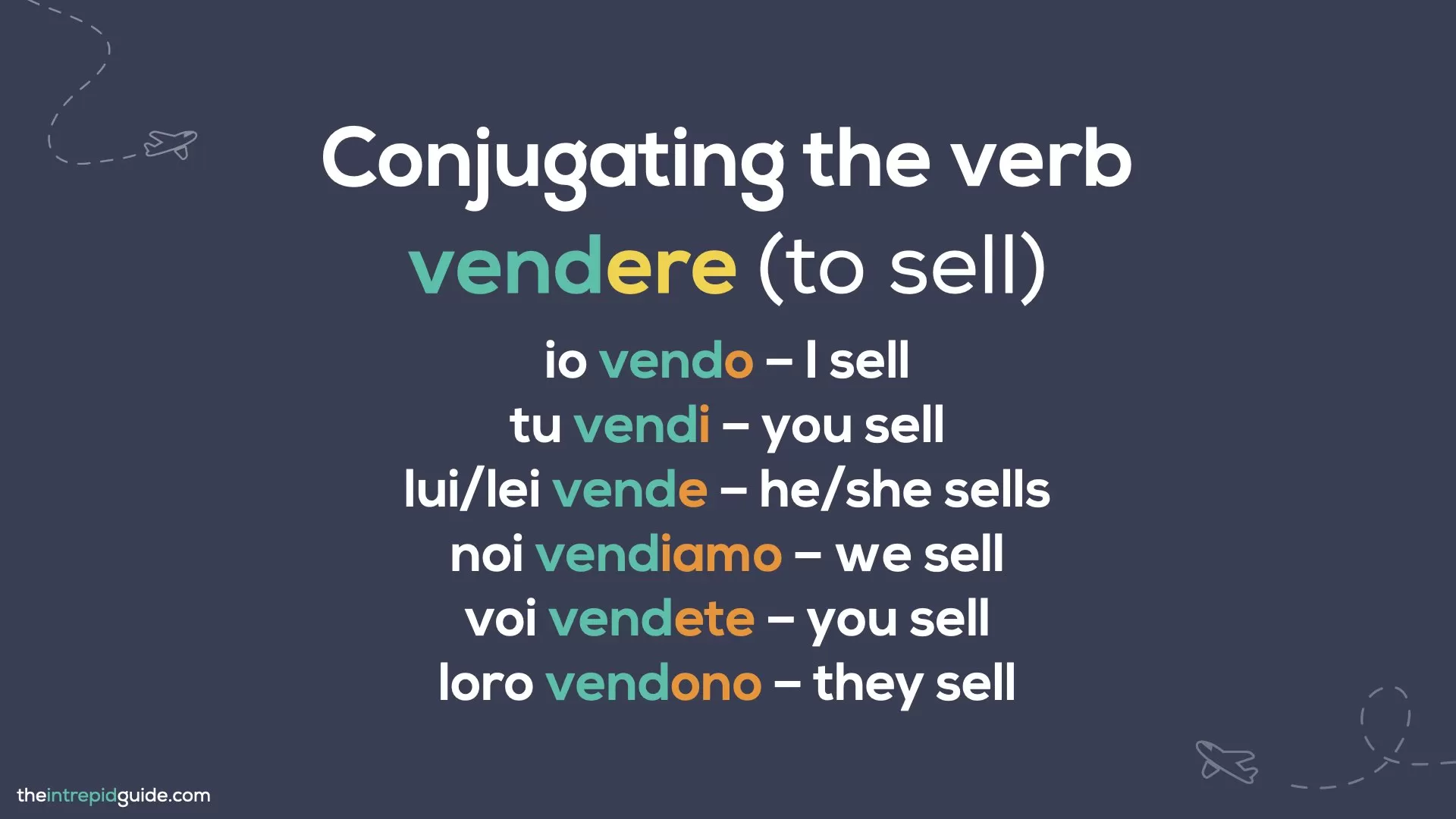
-IRE verb endings
The endings for –ire verbs come in two forms, the first is: -isco, -isci, -isce, -iamo, -ite, -iscono. There are two sets of endings for –ire verbs. The endings for the first form follow a similar pattern to what we’ve already seen. These are: -o, -i, -e, -iamo, -ite, -ono.
- -o (oh) – I
- -i (ee) – you
- -e (eh) – he/she/it
- -iamo (ee-yah-moh) – we
- -ite (ee-teh) – you (plural)
- -ono (oh-noh) – they
With these endings, we can now conjugate the verb partire (par-tee-reh) (to depart, leave) is:
- io parto (ee-oh par-toh) – I depart
- tu parti (too par-tee) – you depart
- Lei/lui/lei parte (lay/loo-ee/lay par-teh) – You (formal)/he/she depart(s)
- noi partiamo (noy par-tee-yah-moh) – we depart
- voi partite (voy par-tee-teh) – you depart
- loro partono (lor-roh par-toh-noh) – they depart
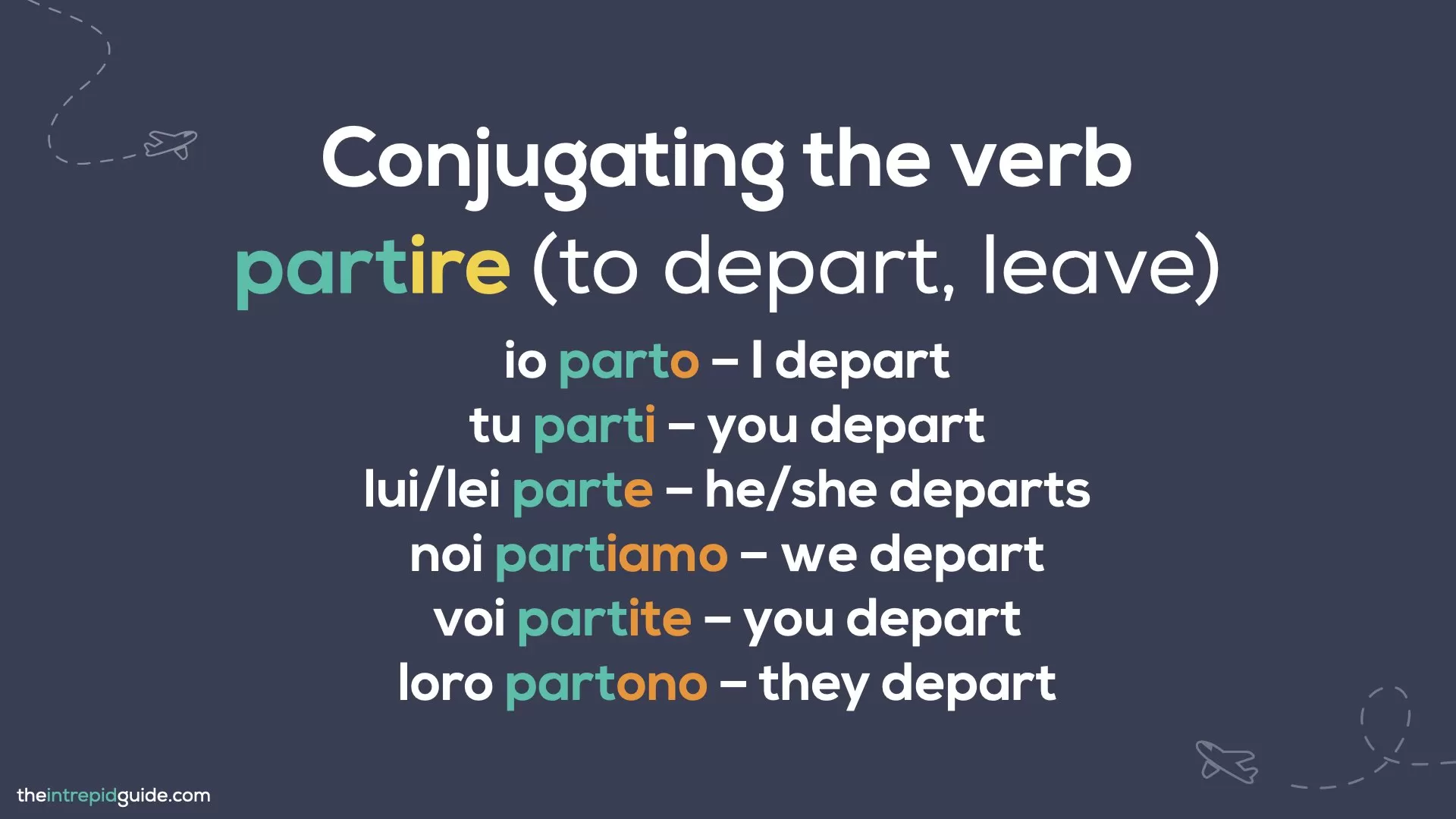
The second form takes the following endings: -isco, -isci, -isce, -iamo, -ite, -iscono. The other type of -ire verb is easier, with the endings:
- –isco (ee-skoh) – I
- –isci (ee-shee) – you
- –isce (ee-sheh) – he/she/it
- –iamo (ee-yah-moh) – we
- –ite (ee-teh) – you (plural)
- –iscono (ees-koh-noh) – they
With these endings, we can now conjugate the verb finire (fee-nee-reh) (to finish) is:
- io finisco (ee-oh fee-nee-skoh) – I finish
- tu finisci (tooh fee-nee-shee) – you finish
- Lei/lui/lei finisce (lay/loo-ee/lay fee-nee-sheh) – You (formal)/he/she finish(es)
- noi finiamo (noy fin-yah-moh) – we finish
- voi finite (voy fee-nee-teh) – you finish
- loro finiscono (lor-roh fee-nee-skoh-noh) – they finish
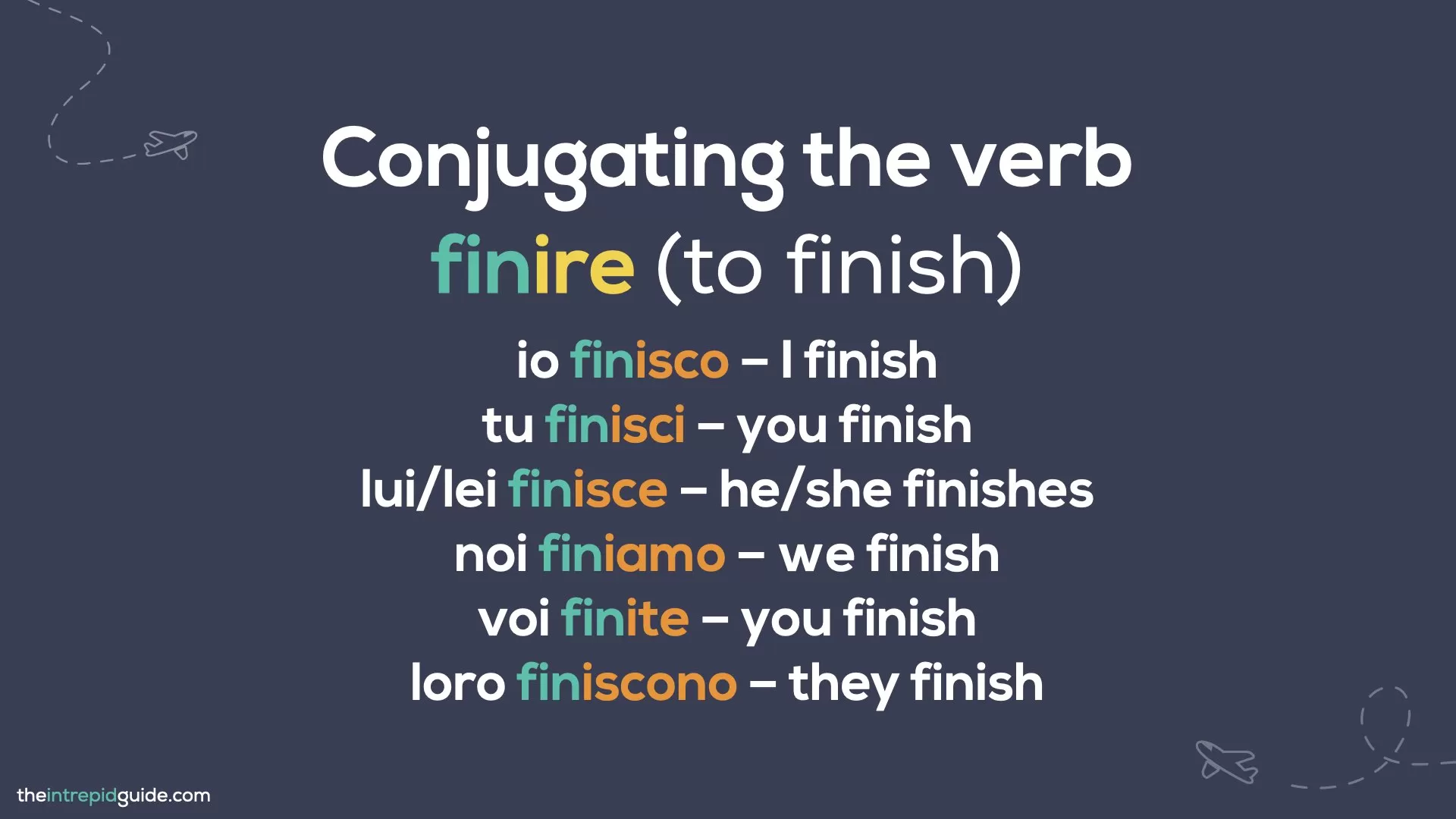
So, how do you know which set of endings an –ire verb takes? A good dictionary should give you an indication if the verb conjugates like partire or finire. Other than that, as with everything else, you learn as you go along!
As you learn Italian, take note of the endings of the verbs and spot the similarities between each verb family. Can you spot any other patterns? For example, ‘I’ always ends in -o and ‘we’ always has -iamo.
Irregular Italian Verbs
Italian also has irregular verbs which means the stem may change form once it has been conjugated. This is called a stem-changing verb, as with the verb bere (beh-reh) meaning ‘to drink’, whose stem changes to bev- when conjugated. Each conjugation has its own set of endings that replaces the ending of the infinitive.
A few common irregular Italian verbs are conjugated as follows:
Irregular -ARE Verb Endings
There are only three irregular -are verbs. They are:
andare (an-da-reh) (to go)
- io vado (ee-oh va-doh) – I go
- tu vai (too vai) – you go
- Lei/lui/lei va (lay/loo-ee/lay vah) – You (formal)/he/she go(es)
- noi andiamo (noy an-dee-ya-mo) – we go
- voi andate (voy an-da-teh) – you go
- loro vanno (lor-roh van-noh) – they go
For more about this verb, learn the difference between ‘andare’ and ‘venire’ here.
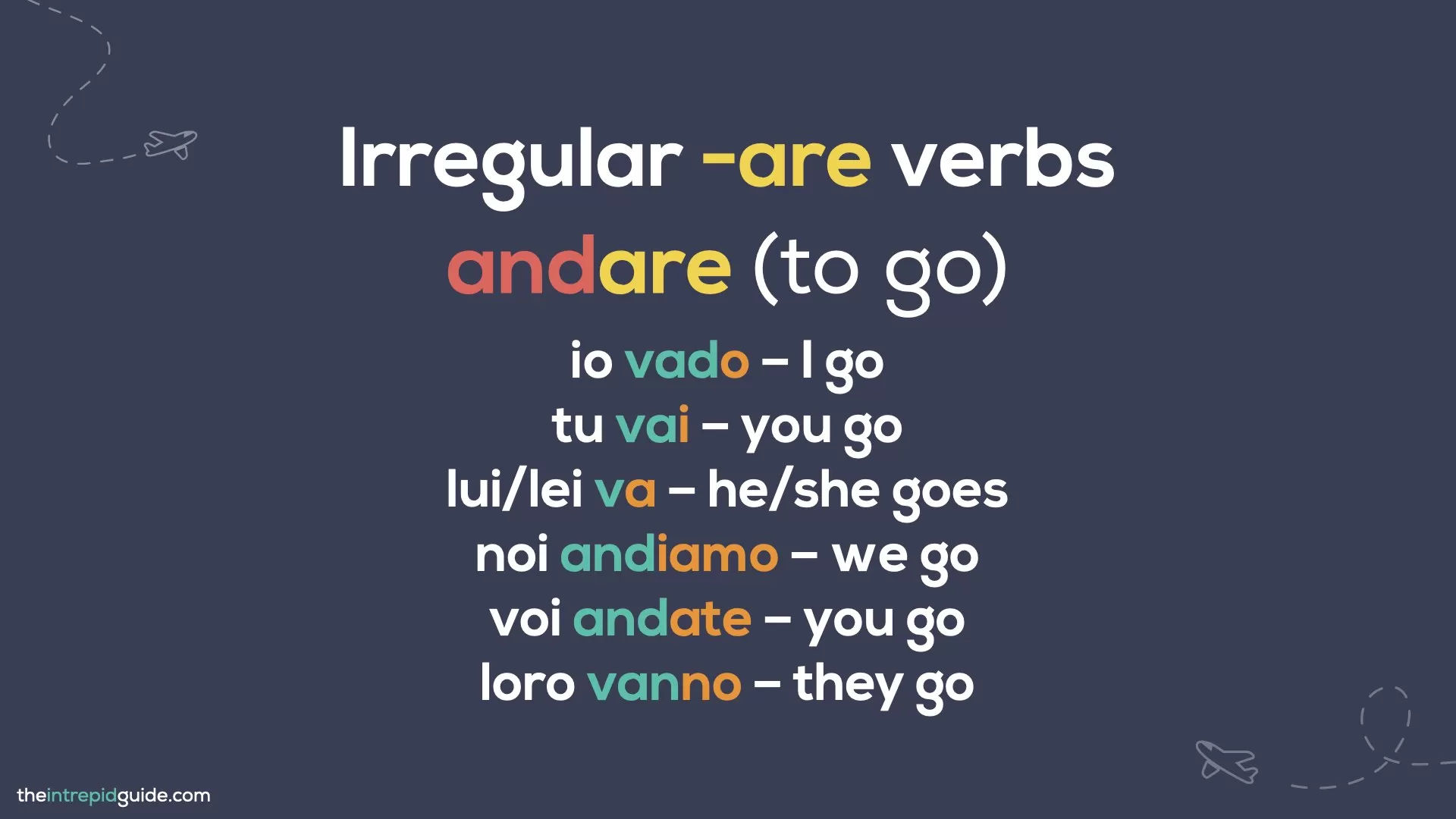
fare (fa-reh) (to do/make)
- io faccio (ee-oh fach-chyo) – I do/make
- tu fai (too fai) – you do/make
- Lei/lui/lei fa (lay/loo-ee/lay fa) – You (formal)/he/she do(es)/make(s)
- noi facciamo (noy vach-chya-moh) – we do/make
- voi fate (voy fa-te) – you do/make
- loro fanno (lor-roh fan-noh) – they do/make
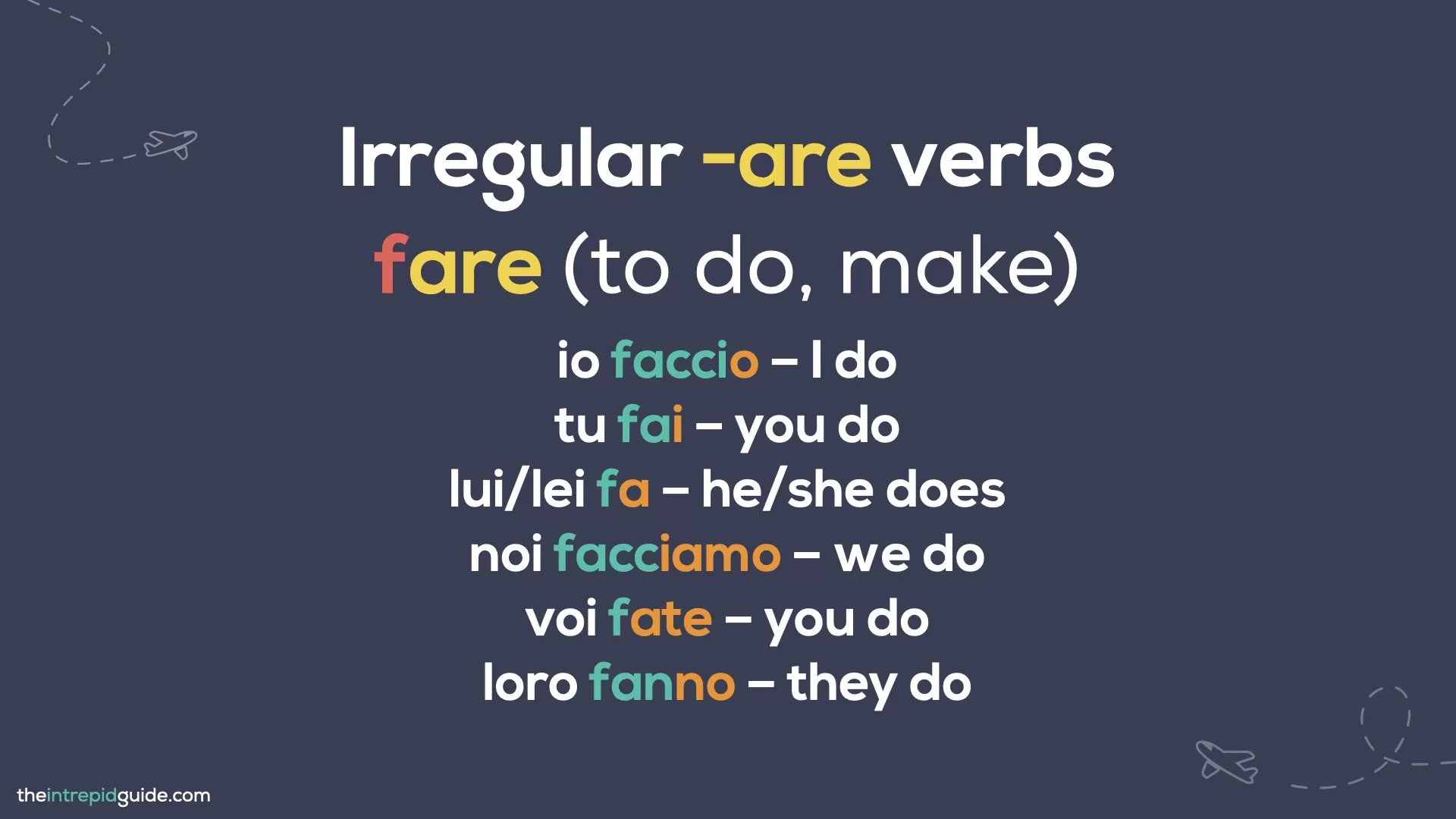
stare (stah-reh) (to be, stay, remain)
- io sto (ee-oh stoh) – I stay
- tu stai (too stai) – you stay
- Lei/lui/lei sta (lay/loo-ee/lay stah) – You (formal)/he/she stay(s)
- noi stiamo (noy stee-ya-mo) – we stay
- voi state (voy sta-te) – you stay
- loro stanno (lor-roh stahn-noh) – they stay
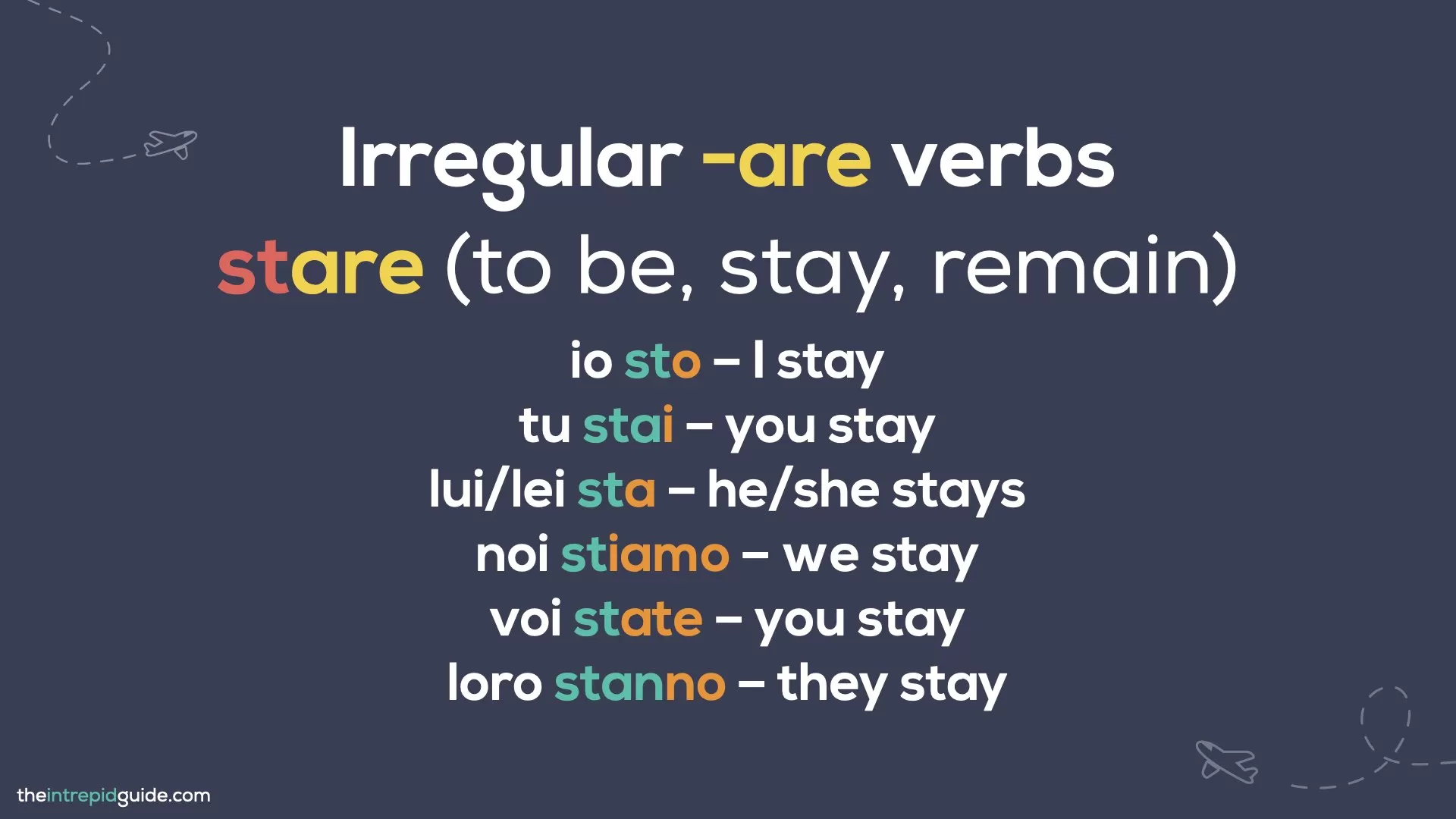 Irregular -ERE Verb Endings
Irregular -ERE Verb Endings
There are many irregular –ere verbs. The two most important are the auxiliary verbs avere and essere, so let’s look at them first.
avere (ah-veh-reh) (to have)
- io ho (ee-oh oh) – I have
- tu hai (too aiee) – you have
- Lei/lui/lei ha (lay/loo-ee/lay ah) – You (formal)/he/she have/has
- noi abbiamo (noy ahb-byah-moh) – we have
- voi avete (voy ah-veh-teh) – you have
- loro hanno (lor-roh ahn-noh) – they have
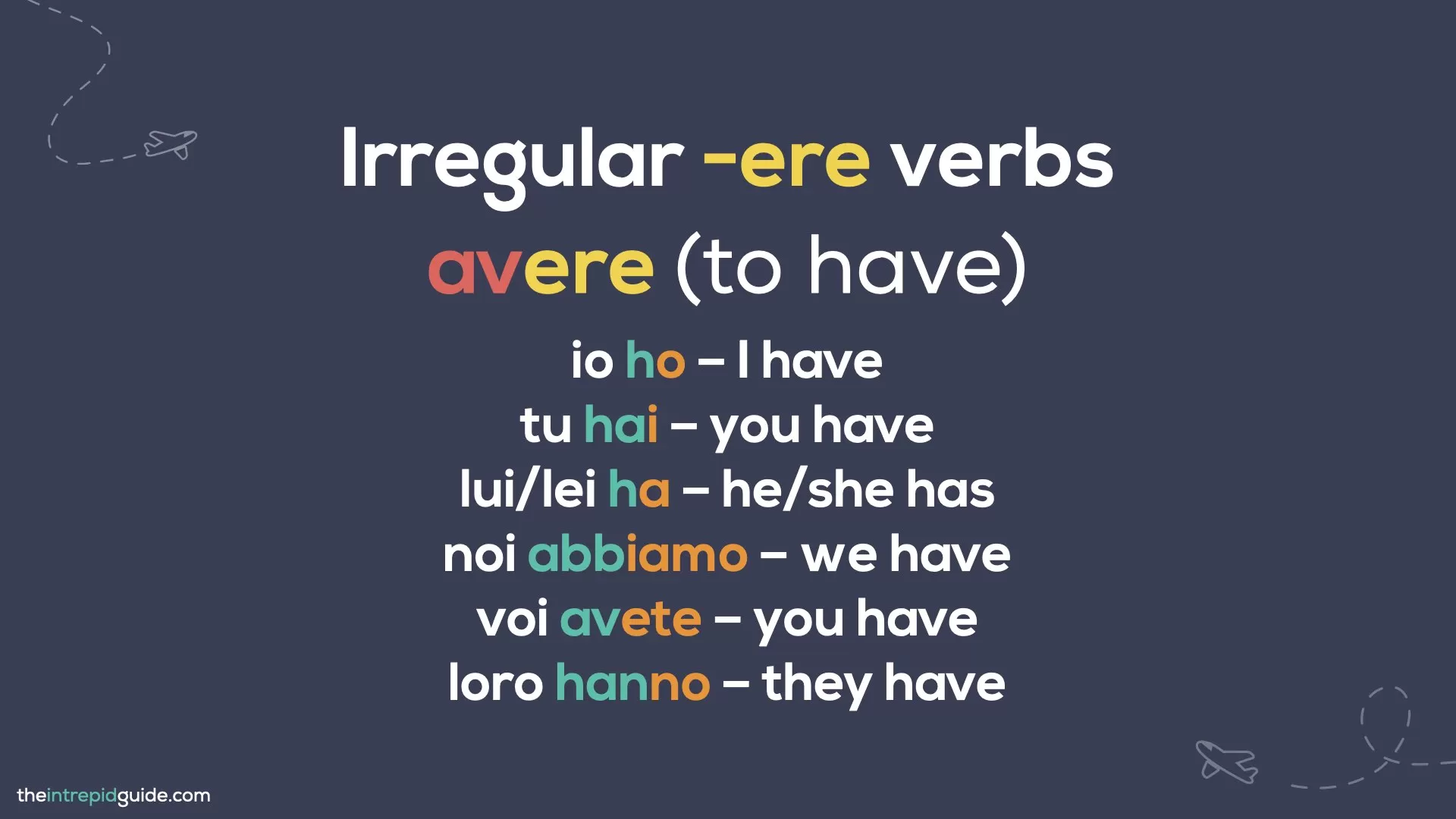 essere (es-seh-reh) (to be)
essere (es-seh-reh) (to be)
- io sono (ee-oh son-noh) – I am
- tu sei (too sey) – you are
- lui/lei è (lay/loo-ee/lay eh) – You (formal)/he/she are/is
- noi siamo (noy see-yah-moh) – we are
- voi siete (voy see-yeh-teh) – you are
- loro sono (lor-roh sohn-noh) – they are
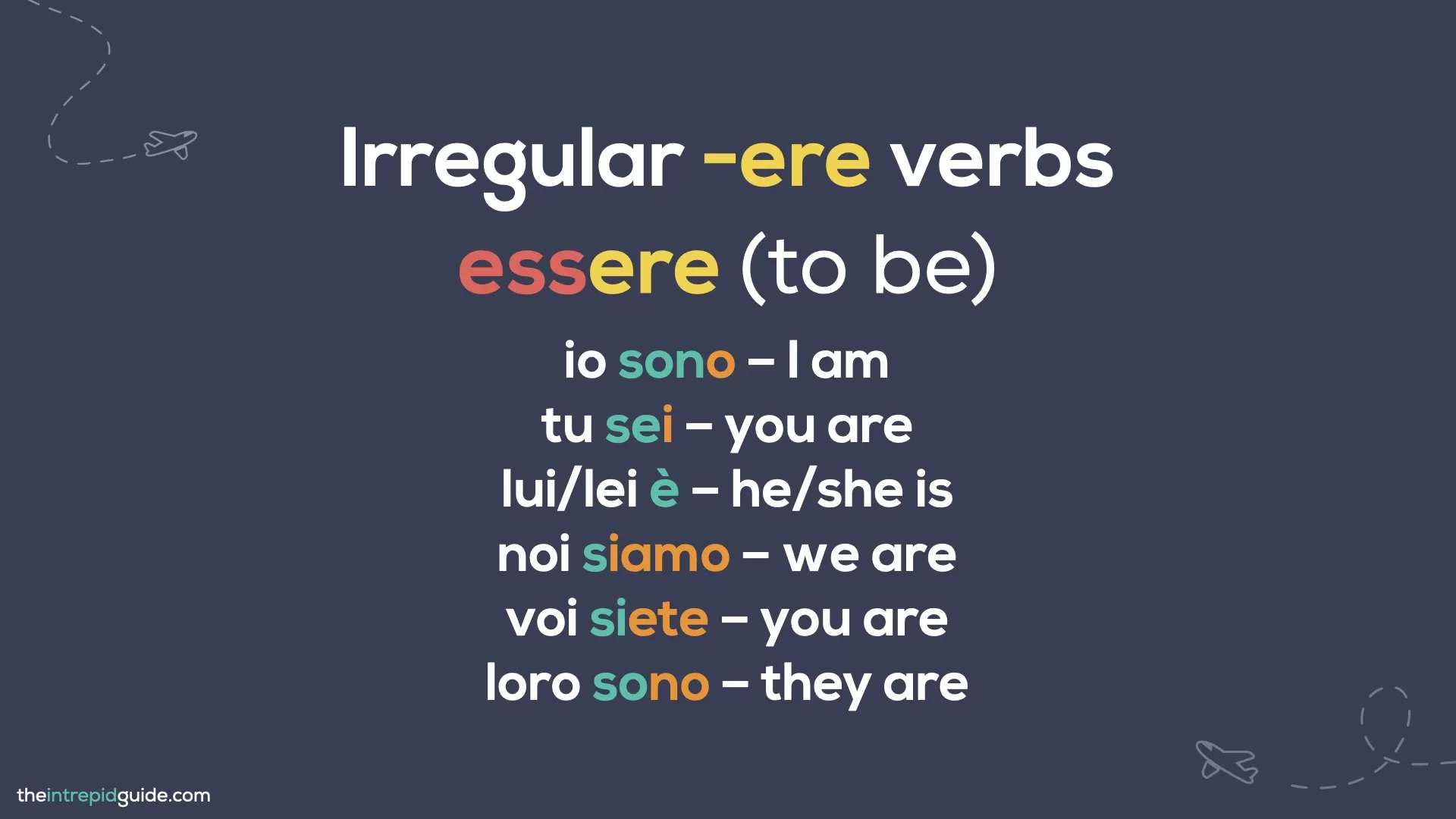
bere (be-reh) (to drink)
- io bevo (ee-oh beh-voh) – I drink
- tu bevi (too beh-vee) – you drink
- Lei/lui/lei beve (lay/loo-ee/lay beh-veh) – You (formal)/he/she drink(s)
- noi beviamo (noy bev-ya-mo) – we drink
- voi bevete (voy bev-veh-teh) – you drink
- loro bevono (lor-roh bev-on-noh) – they drink
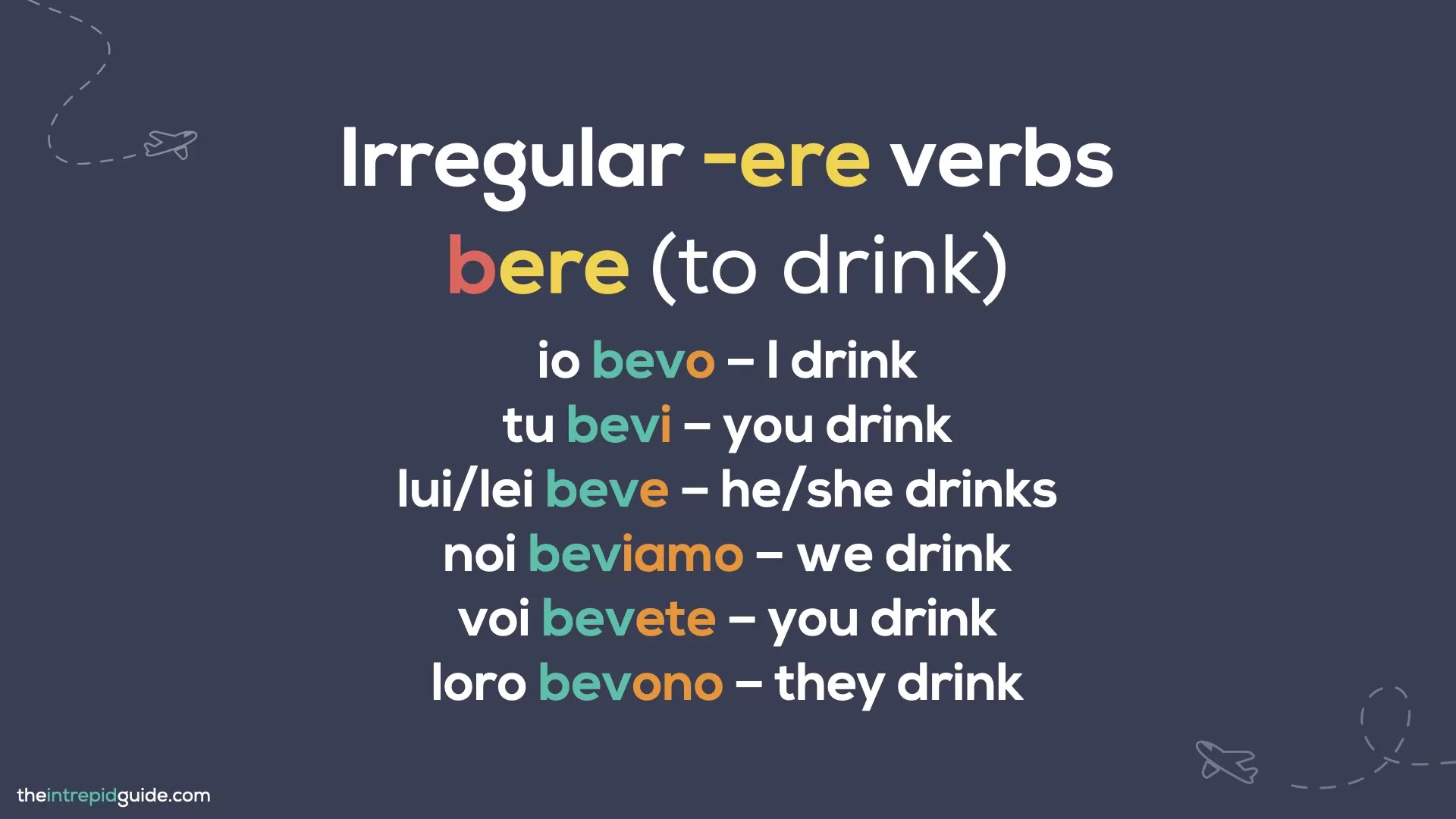
sapere (sap-peh-reh) (to know)
- io so (ee-oh soh) – I know
- tu sai (too sai) – you know
- Lei/lui/lei sa (lay/loo-ee/lay sa) – You (formal)/he/she know(s)
- noi sappiamo (noy sap-pya-mo) – we know
- voi sapete (voy sah-peh-teh) – you know
- loro sanno (lor-roh sahn-noh) – they know
For more about this verb, learn the difference between ‘sapere’ and ‘conoscere’ here.
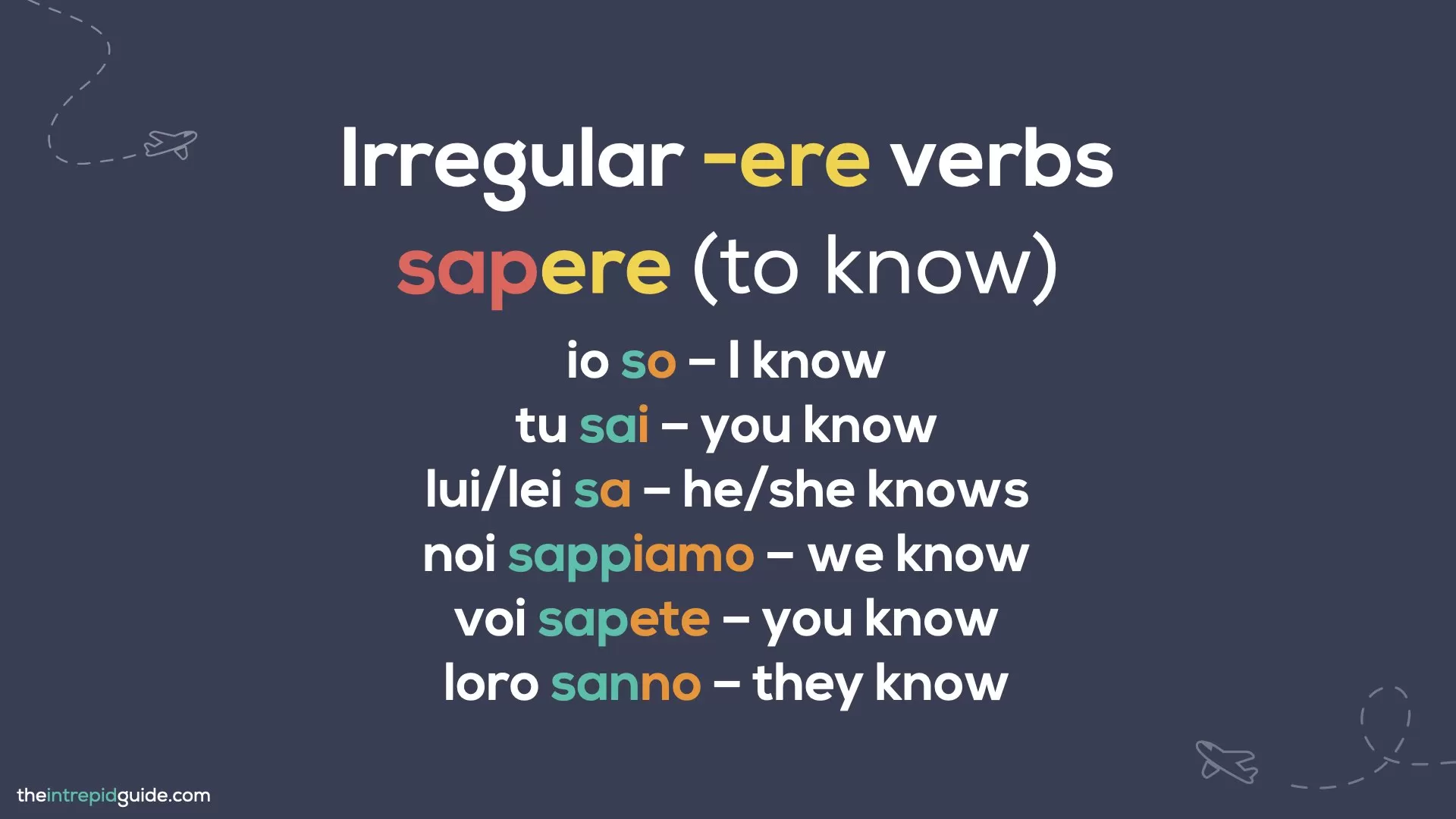
potere (poh-teh-reh) (to be able, can). This is one of the so-called Italian modal verbs which are super powerful building block.
- io posso (ee-oh pos-so) – I can
- tu puoi (too pwoy) – you can
- Lei/lui/lei può (lay/loo-ee/lay pwoh) – You (formal)/he/she can
- noi possiamo (noy pos-sya-mo) – we can
- voi potete (voy pot-teh-teh) – you can
- loro possono (lor-roh pos-soh-noh) – they can
Irregular -IRE Verb Endings
The most common irregular –ire verbs are:
dire (dee-reh) (to say, tell)
- io dico (ee-oh dee-koh) – I say/tell
- tu dici (too dee-chee) – you stay
- Lei/lui/lei dice (lay/loo-ee/lay dee-cheh) – You (formal)/he/she say(s)/tell(s)
- noi diciamo (noy dee-chya-mo) – we say/tell
- voi dite (voy dee-teh) – you say/tell
- loro dicono (lor-roh dee-kon-noh) – they say/tell
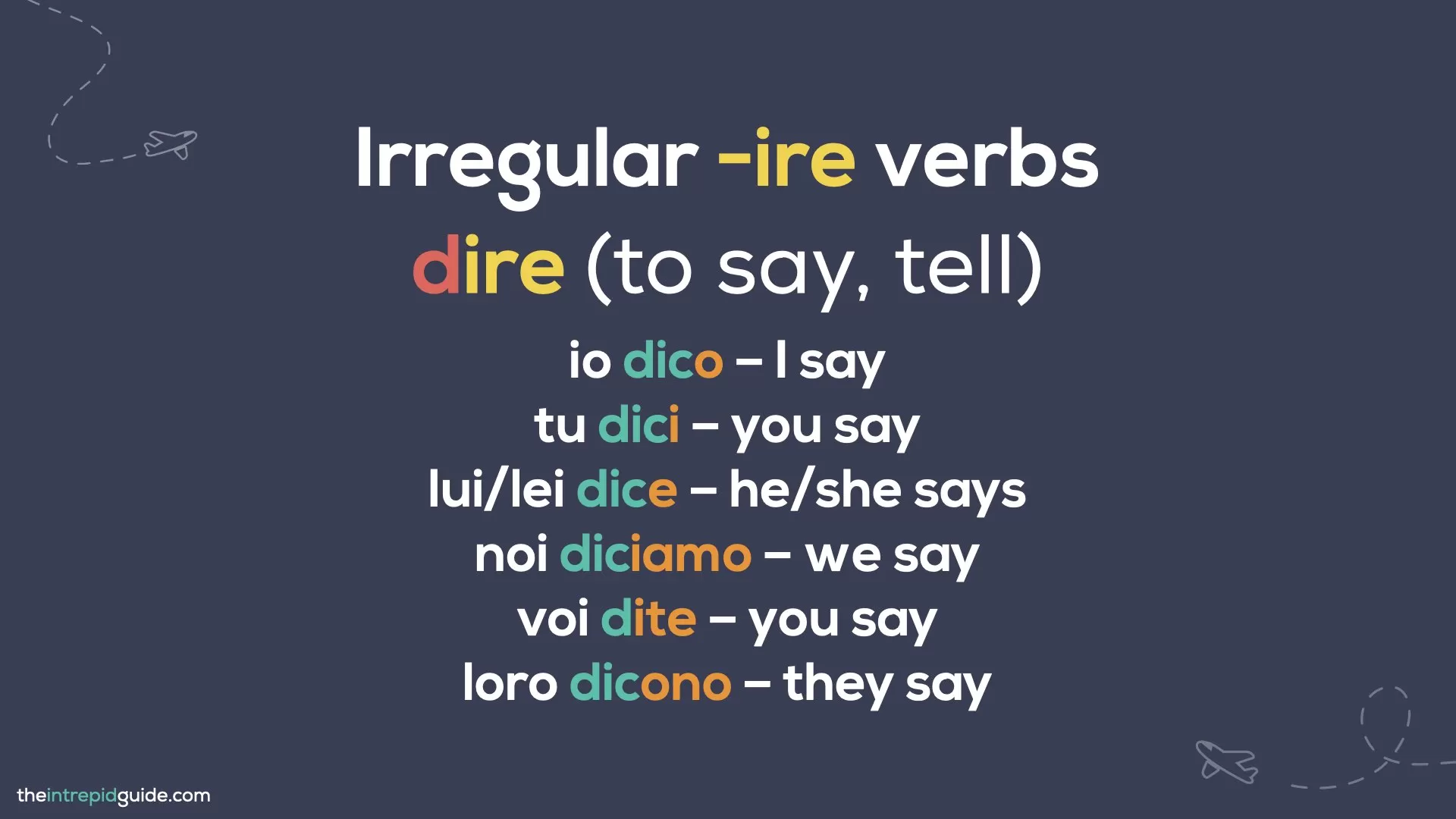
venire (veh-nee-reh)(to come)
- io vengo (ee-oh ven-goh) – I come
- tu vieni (too vee-yeh-nee) – you come
- Lei/lui/lei viene (lay/loo-ee/lay vee-yeh-neh) – You (formal)/he/she come(s)
- noi veniamo (noy ven-ya-mo) – we come
- voi venite (voy ven-vee-teh) – you come
- loro vengono (lor-roh ven-goh-noh) – they come
For more about this verb, learn the difference between ‘venire’ and ‘andare’ here.
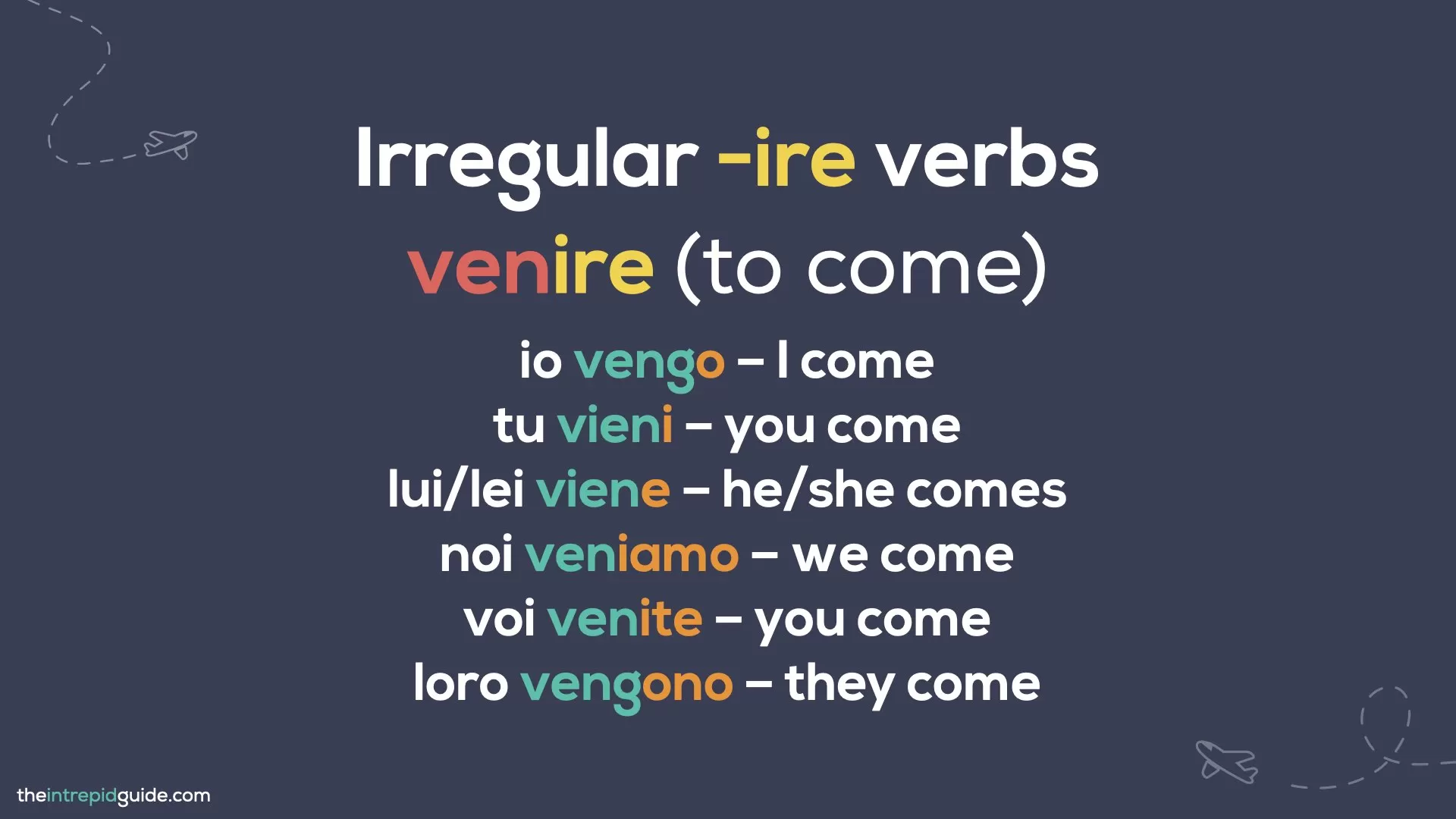
So, that’s how you conjugate verbs in Italian. Once you master how to do this in the present tense, you’ll be able to apply the same principles to all the other Italian tenses including the Past tense and future tense.
My top tip for becoming more confident and quicker at conjugating verbs is with practice. Write short phrases about people in your life and use a verb conjugation app like Conjuu that allows you to practice each verb family individually and different Italian tenses too!
If you’re serious about learning Italian, make sure you get my free guide 7 common mistakes in Italian and how to avoid them!
Learn conversational Italian with my unique 80/20 method!
Travelling to Italy? Don’t be treated like a tourist! Live your best travel experiences and learn Italian for less than the cost of eating at a tourist trap restaurant or a taxi driver who has “taken you for a ride”. In addition to my free Italian travel phrase guides, I’ve made it even easier for you to master the Italian language so you can create lifelong memories as you mingle with locals, get local tips, avoid tourist traps, and make new friends. Who knows you, you may even be invited over for afternoon tea by a lovely Sicilian family, like I was! Read all about how speaking Italian changed my life and check out The Intrepid Guide Languages courses here.
Here’s what my students are saying:

I really enjoyed the Master Italian for Travel FAST course, it certainly exceeded my expectations. The learning methodology is great, and easy to follow and found that I progressed much faster in the last 4 weeks than I ever did on my own or using other language apps. Grazie mille Michele, I can’t wait until I can put my new skills into action! – Roma Small
Click here for instant access!
Learning Italian? Check out these Italian language guides
- Top 24 Most Important Verbs in Italian (Plus PDF Cheat-Sheet & Quiz)
- 41 Italian Greetings: How to Say ‘Hello’ in Italian Like a Local
- 125 Most Common Italian Phrases for Travel You’ll Ever Need [PLUS Printable]
- Is Italian Hard to Learn? 7 Common Mistakes & How to Avoid Them
- Master Days of the Week in Italian (7 Simple Memory Hacks)
- Italian Numbers: How to Count in Italian From 0 to 1 Billion (Plus PDF Download)
- How to Order Food & Drinks in Italian [Italian for Beginners]
- 15 Italian Words You Should NEVER Mispronounce [& How Not To]
- 11 Effective Hacks That’ll Help You Learn Italian So Much Faster
- Top 14 Italian Words You Should NEVER Say [& What to Use Instead]
- 20 Hilarious Everyday Italian Expressions You Should Use
- Romanesco: 25 Cool Roman Dialect Words You Should Use in Rome
- 10 Reasons Why Learning Italian Will Change Your Life
- 10 Italian Expressions Italians Love Saying
- Italian for Beginners | 8 DEADLY Mistakes in Italian (& How to Avoid Them)
- 10 Italian Phrases That Will Instantly Make You Sound more Italian
- Funny Italian Sayings: 26 Food-Related Insults You Won’t Forget
- 15 Romantic Italian Films That’ll Make You Love Italy Even More
- How to Master Common Italian Phrases for Travel (Like a Local!)
Like it? Pin it for later!
